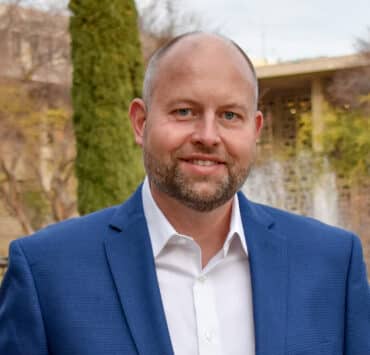|
|
Can an office environment not only support employee health and productive collaborations but also keep workers mindful of who the customer is? The answer is yes. The conference rooms at Next Insurance in Palo Alto, California, are named for local businesses supported by the company such as Boichik Bagels, Coastal Curl, and Kepler’s Books. It’s a clever way to remind workers of their product—insurance for small businesses—and a colorful approach by Bryan Porcher to combine his unusual dual educational background.
Porcher, the head of workplace and real estate at Next Insurance, has a bachelor’s degree in interior design and a master’s in organizational psychology. While earning his graduate degree, a professor asked the class what their alternative would be if it was not their current course of study. Porcher’s thoughts went back to interior design. It was a moment when he figured out that he could, and should, combine the two.

It is uncommon for employee engagement experts to also be commercial interior designers. But what Bryan Porcher does for Next Insurance—and much of which he has done with previous employers such as Google and Cisco Systems—involves using psychology to plan interiors. He isn’t simply responsible for some interesting physical components of the workplace environment. He also devises the programming around those components to make them work.
For example, he saw a valid need for and championed nap pods at Google. “I had to lobby for $15,000 to pilot the project,” Porcher says. Part of how he got the funding was to cite famous leaders who napped: Thomas Edison, Winston Churchill, Albert Einstein, and Margaret Thatcher. Once the pilot succeeded and the pods were rolled out in all offices, he saw the real effects of them. “They were particularly popular with sleep-deprived new parents and security team members, but it also helped reconceptualize what people have permission to do.”
At Next Insurance, Porcher introduced a different concept of multipurpose wellness rooms. They are used by meditators, new parents, yoga practitioners, and others who come here to alleviate workday stress. The office also has a studio with a green screen for videos and podcasts, as well as a recreational room with a variety of games and a beloved popcorn machine.
“We have to encourage the stickiness of human relationships.”
Bryan Porcher
Another problem faced by many companies with open-concept offices is how sounds of impromptu deskside meetings might interrupt nearby workers. Porcher’s invented solution is “Shush Shacks,” which are basically mini enclosures that provide space for conversations that are acoustically buffered from those around them.
As with many companies, Next Insurance wants its employees in the office at least part of the time. In the office, they are more likely to collaborate with others from other disciplines. So for Halloween in 2022, Porcher gave teams of people a challenge that came with a small budget per team and a conference room. Their task was to create a haunted house—a project that would summon previously untapped staging and acting skills from the participants.
“We had ten teams, headed by what we call our ‘culture carriers,’ and got a beautiful response,” he says. “It’s what we try to impress upon our people, that this is a safe space with a blank canvas where they can generate ideas on their own.

These are clear examples where facilities and management values coincide. There happen to be some fortunate components of the office that precede Porcher’s arrival. There are two connecting hallways surrounded by exterior landscaping that can be seen through windows—a clear example of biophilia at work—that support employees’ best efforts. But he also focuses on building interpersonal management skills with employees whom they want to retain and nurture.
“I had the benefit of smart people mentoring me,” he says. “So with our own rising executives, I teach active listening skills and discernment on taking appropriate risks.” The goal is in part to build trust, and encourage ‘intrapreneurs,’ or the kinds of employees who take ownership of their parts of the enterprise. The built environment is a way to reinforce this as evidenced by our visible ‘Be Unstoppable’ sign that represents one of our four core values.”
“It’s what we try to impress upon our people, that this is a safe space with a blank canvas where they can generate ideas on their own.”
Bryan Porcher
Porcher is a keen observer on how companies are navigating the work-from-home era, and definitively believes that at least some presence in a physical office is essential. “We have to encourage the stickiness of human relationships,” he says. “People stay in jobs for various reason. They will still leave if they have poor managers, but still tend to be more engaged and loyal to companies when they have close friends supporting them at the workplace.”
For over 50 years, RMW has been creating inspired experiences through the power of design. Informed by a culture of curiosity and possibility, we see every project as a welcome opportunity to deliver exceptional service while expressing the unique vision of each client. For Next Insurance, we delivered a vibrant, team-oriented workplace that celebrates community and facilitates Bryan’s focus on employee engagement. It’s truly a place that people want to experience and be part of.


